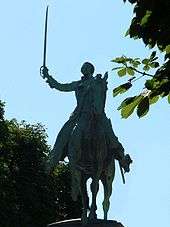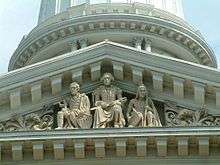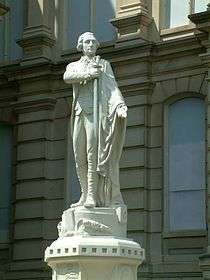Honors and memorials to the Marquis de Lafayette
Further information: Lafayette (disambiguation)
See also: South Fayette township (Pittsburgh), North Fayette township (Pittsburgh), Fayette (disambiguation), Fayetteville (disambiguation), Fayette Township (disambiguation), Lafayette Township (disambiguation), and Lafayette Park (disambiguation)

Gilbert du Motier, Marquis de Lafayette (1757–1834), a French aristocrat and Revolutionary War hero, was widely commemorated in the U.S. and elsewhere. Below is a list of the many homages and/or tributes named in his honor:
Honors

U.S. Postage Stamp, 1957 issue, 3c, commemorating 200th anniversary of the birth of La Fayette
- In 1792, James McHenry, whom Lafayette considered a good friend, purchased a a tract called Ridgely's Delight about a mile west of Baltimore. On it, he built a country seat on 95 acres and named it Fayetteville in his honor.[1]
- In 1824, the U.S. government named Lafayette Park in his honor; it lies immediately north of the White House in Washington, D.C.
- In 1826, Lafayette College was chartered in Easton, Pennsylvania. Lafayette was honored with a monument in New York City in 1917.[2] Portraits display Washington and Lafayette in the chamber of the U.S. House of Representatives.[3] Numerous towns, cities, and counties across the United States were named in his honor.
- In 1834, upon Lafayette's death, American President Andrew Jackson ordered that Lafayette be accorded the same funeral honors as John Adams and George Washington. Therefore, 24-gun salutes were fired from military posts and ships, each shot representing a U.S. state. Flags flew at half mast for thirty-five days, and "military officers wore crepe for six months".[4][5] The Congress hung black in chambers and asked the entire country to dress in black for the next thirty days.[6]
- In 1899, Lafayette appeared with Washington on a U.S. coin, the Lafayette dollar that was minted in 1899 (though showing the year 1900). It was produced to raise money for a statue of him that was erected in Paris.
- On July 4, 1917, shortly after the U.S. entered World War I, Colonel Charles E. Stanton visited the grave of Lafayette and uttered the famous phrase "Lafayette, we are here." After the war, a U.S. flag was permanently placed at the grave site. Every year, on Independence Day, the flag is replaced in a joint French-American ceremony.[7] The flag remained even during the German occupation of Paris during World War II.
- In 1943, on visiting Corsica, General George S. Patton commented on how the Free French forces had liberated the birthplace of Napoleon, and promised that the Americans would liberate the birthplace of Lafayette.
- In 1958, the Order of Lafayette was established by U.S. Representative Hamilton Fish III, a World War I veteran, to promote Franco-American friendship and to honor Americans who fought in France. The frigate Hermione, in which Lafayette returned to America, has been reconstructed in the port of Rochefort, Charente-Maritime, France.[8]
- In 2002, although he became a naturalized American citizen during his lifetime,[9][10][11] Lafayette was granted honorary United States citizenship by the United States Congress.[12]
Military and maritime

The aircraft carrier USS Langley was renamed La Fayette by France
Several warships were named after Lafayette:
- The French Navy acquired USS Langley in 1951 and renamed it La Fayette.
- Lafayette is a modern stealth frigate is also named after him.
- La Fayette is also the name of a ship class.
- The French ocean-liner SS Normandie was to be the troopship USS Lafayette after being acquired by the US Government, but was destroyed by a fire before conversion to the new role was completed. The name was later given to a ballistic missile submarine.
- The Lafayette Escadrille was an escadrille of the French Air Service during World War I composed largely of American volunteer pilots.
Counties, cities, streets and squares
- City of Fayetteville in North Carolina. While many cities are named after Lafayette, Fayetteville was the first, and holds the distinction of being the only one he actually visited, arriving in Fayetteville by horse-drawn carriage in 1825 during Lafayatte's visit to the United States from July 1824 to September 1825 celebrating the 50th anniversary of the Battle of Bunker Hill
- City of Lafayette in California
- City of Lafayette in Indiana. It is the county seat of Tippecanoe County and the home of Purdue University. The city was named after Lafayette during his tour of America.
- City of Lafayette in Louisiana
- County of Lafayette in Arkansas
- Lafayette Square in Buffalo, New York,[13] where he spoke during his nationwide tour in 1825.[14]
- Lafayette Square, in Washington, D.C.
- Lafayette Square in Saint Louis, Missouri
- Lafayette Park in Saint Louis, Missouri was created in 1833 as one of the first public parks created in the City of Saint Louis and was named in his honor in 1854.
- Mount Lafayette, a mountain in the White Mountains of New Hampshire.
Streets
Many streets around the United States (and abroad) are named for Lafayette, including:
- Lafayette Street in New Haven, Connecticut
- Lafayette Street in Williston Park
- Lafayette Street in Manhattan
- New York City has five Lafayette Streets, one in each borough, as well as a Lafayette Avenue in Brooklyn.
- Lafayette Road in New Hampshire that extends from the Massachusetts border in Seabrook to Portsmouth
- Avenue de Lafayette is located in the Downtown Crossing section of Boston.
- Lafayette Avenue in Baltimore.
- Lafayette Boulevard in Bridgeport, Connecticut
- Lafayette Road in Harrington Park, New Jersey
- Lafayette Street in Cape May, New Jersey
- Lafayette Street in Waltham, Massachusetts, located near a critical area during the Revolution.
- Ulice Lafayettova ("Lafayette Street") in Olomouc, Czech Republic, is near the site of Lafayette's imprisonment.
Lafayette in sculpture

Monument to Lafayette in Paris
- Lafayette Bust by Houdon, 1789, now at Gilcrease Museum, Tulsa, Oklahoma.
- Statue by Bartholdi in Union Square Park, Manhattan, New York, 1876
- Pediment on the Tippecanoe County Courthouse, Lafayette, Indiana, 1882
- Lafayette on the Green, University of Vermont, 1883
- LaFayette Fountain by Lorado Taft in Lafayette, Indiana, 1887
- Statue in Lafayette Square, Washington, D.C., 1891.
- Statue of Lafayette and Washington by Bartholdi, Place des États-Unis (United States Plaza), Paris, France, 1895
- Equestrian statue by Paul Wayland Bartlett, 1908, Cours-la-Reine, Paris. An early version appears on the Lafayette dollar.
- Built in 1975, a statue of Lafayette stands atop a fountain in the courthouse square in LaGrange, Georgia.
- Equestrian statue by Paul Bartlett, Metz, France 1919, destroyed by German occupation forces and replaced by another statue by M . Goutin in 2004
- Statue of Lafayette on Union Avenue & Warren Street in Havre de Grace, Maryland, 1976
- Life-size statue of Lafayette on the University of Vermont campus green, Burlington, Vermont, 1883
- Equestrian statue in front of the Washington Monument in Baltimore, Maryland, 1924
- Statue outside of the Gen. Horatio Gates House and Golden Plough Tavern, York, Pennsylvania, 2007
- Statue on Washington Street in Hartford, CT. Sculptor, Paul Wayland Bartlett. Date of Dedication: 09/21/1957. The original of this statue stands in the Louvre, a gift to France from the school children of the United States.
Gallery
-

Bust by Houdon (1789)
-

Place des États-Unis, Paris, France (1866)
-

Statue by Bartholdi, Union Square Park, Manhattan, New York, (1876)
-

Pediment on the Tippecanoe County Courthouse, Lafayette, Indiana (1882)
-

LaFayette Fountain; Lafayette, Indiana (1887)
References
- ↑ Bernard Christian Steiner (1907). The life and correspondence of James McHenry: Secretary of War under Washington and Adams. The Burrows Brothers Company.
- ↑ "Marquis de Lafayette". New York City Department of Parks & Recreation. 7 March 2002. Retrieved 11 August 2008.
- ↑ Ike Skelton (22 May 2007). "House Record: Honoring The Marquis De Lafayette On The Occasion Of The 250th Anniversary Of His Birth: Section 29". GovTrack.us. Retrieved 11 August 2008.
- ↑ Gaines, p. 448
- ↑ Clary, p. 448
- ↑ Clary, p. 449
- ↑ "Lafayette and the American Flag: The Fourth of July Ceremony". Retrieved 19 September 2013.
- ↑ Robert Kalbach. "L'Hermione". L'Hermione (in French). L’association Hermione-La Fayette. Retrieved 11 August 2008.
- ↑ Speare, Morris Edmund "Lafayette, Citizen of America", New York Times, 7 September 1919. The article contains a facsimile and transcript of the Maryland act:"An Act to naturalize Major General the Marquiss de la Fayette and his Heirs Male Forever... Be it enacted by the General Assembly of Maryland—that the Marquiss de la Fayette and his Heirs male forever shall be and they and each of them are hereby deemed adjudged and taken to be natural born Citizens of this State and shall henceforth be instilled to all the Immunities, Rights and Privileges of natural born Citizens thereof, they and every one of them conforming to the Constitution and Laws of this State in the Enjoyment and Exercise of such Immunities, Rights and Privileges."
- ↑ Folliard, Edward T. "JFK Slipped on Historical Data In Churchill Tribute" Sarasota Journal, 25 May 1973.
- ↑ Cornell, Douglas B. "Churchill Acceptance 'Honors Us Far More'" Sumter Daily Item, 10 April 1963.
- ↑ Public Law 107-209
- ↑ "Lafayette Square". Buffalo Niagara Convention & Visitors Bureau. Retrieved March 25, 2009.
- ↑ Kowsky, p. 88
Works cited
- Kowsky, Francis R., Mark Goldman, Austin Fox, John D. Randall, Jack Quinan, and Teresa Lasher (1982). Buffalo Architecture: A Guide (Third printing ed.). The MIT Press. ISBN 0-262-02172-2.
- Clary, David (2007). Adopted Son: Washington, Lafayette, and the Friendship that Saved the Revolution. Bantam Books. ISBN 978-0-553-80435-5.
- Gaines, James R. (2007). For Liberty and Glory: Washington, La Fayette, and Their Revolutions. W.W. Norton & Co. ISBN 978-0-393-06138-3.
This article is issued from Wikipedia - version of the 10/8/2016. The text is available under the Creative Commons Attribution/Share Alike but additional terms may apply for the media files.